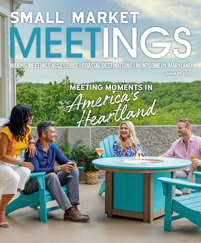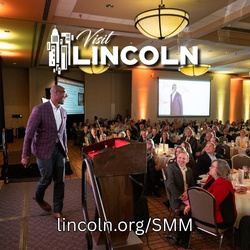Raleigh, North Carolina
Raleigh firmly traces its renaissance to reopening its main street, Fayetteville Street, which runs from the state Capitol to the Duke Energy Center for the Performing Arts, in 2006.
“The street was reopened to be closed [for events],” said Loren Gold, executive vice president of the Greater Raleigh Convention and Visitors Bureau. “The street reopening party had 60,000 people, and now we have a series of music and craft beer events. The World of Bluegrass attracts 180,000 people for a weeklong, streetlong free festival.”
Two years after the street reopening, the 500,000-square-foot, LEED-certified Raleigh Convention Center opened, becoming the cornerstone of downtown Raleigh and anchoring a flurry of renovation and construction. In 2008, the 400-room Raleigh Marriott City Center opened, and the 353-room Sheraton Raleigh Hotel completed a total renovation. In 2010, the city debuted City Plaza, a “public living room” with LED light towers, programmable fountains and public art that rotates every quarter.
On the food-and-beverage side, Raleigh has become the epicenter of a burgeoning craft brewery scene, with 23 in the county and 10 of those in downtown Raleigh. Crank Arm Brewing, Trophy and Pizza Co. and Raleigh Brewing Company in downtown all have rental space for groups. “We’re also seeing a major movement on the culinary product side,” said Gold. “We’ve got four different local coffee roasters and three chocolatiers.”
Following the initial hotel revitalization from the convention center opening, many hotel groups have expressed new interest in the city, and there are five hotels looking at various projects now, according to Gold. The county’s first boutique hotel, the 45-room Mayton Inn, just opened its doors last month.
St. Petersburg, Florida
As a barrier island, St. Petersburg-Clearwater qualifies as a beach destination, with 36 miles of white-sand beach ranging from golf resort chic to protected parkland, but there’s so much going on in the city that your attendees may forget about the shoreline — for a few days at least.
“One of the key things that we offer meeting planners is that we have a lot of unique options for off-site events,” said Suzanne Scully, director of sales, meetings and conventions for Visit St. Petersburg/Clearwater. “At the Morean Arts Center, you can do your own blown glass, and William Dean Chocolates in Clearwater opens his kitchen up and caters with the most exquisite hors d’oeuvres and champagne while you learn to make your own chocolate. His chocolates were featured in the ‘Hunger Games’ movies.”
In the past 10 years, thanks in part to the opening in 2011 of the Dali Museum, the largest collection of Salvador Dali’s works outside of Europe, the St. Petersburg art scene has come into its own and has spawned high-concept new event venues around the city. At the Dali Museum, groups can choose to dine in the sculpture-filled Avant-garden, meet in the glass-enclosed Raymond James Community Room overlooking the gardens or pose for a group photo at the freestanding helical staircase during a reception wandering the galleries.
The St. Petersburg’s Museum of Fine Arts, which opened a new wing in 2008, allows groups to blend art and nature with its gardens and waterfront setting.
“You can have hors d’oeuvres on the waterfront, walk through and see the Picasso exhibit and have dinner in the garden,” said Scully.
The Morean Art Center is home to a clay arts center, a glass studio and a 10,000-square-foot gallery of Dale Chihuly glass installations. Each of the center’s four buildings is available for private rentals, which, in the case of the Glass Studio and Center for Clay, housed in a historic train station, can include demonstrations. This fall, the Chihuly Collection will move to a new purpose-built home near the main Morean Center building.
Lexington, Kentucky
Lexington may have a population of just over 300,000, but its eight local universities mean that population leans young and highly educated. “We’ve got some university city vibe, but we also have people moving here to be entrepreneurs and do a start-up,” said Marci Krueger-Sidebottom, vice president of sales and services for the Lexington Convention and Visitors Bureau. “I’m always asking these people if we really have enough to offer, and they say there’s great energy here.”
In the last five years, the Lexington restaurant scene has hit its stride with a focus on Southern staples using local ingredients, and the city now has 130 locally owned restaurants. Walkable Jefferson Street near downtown, home to Country Club, a renovated garage where all meats are smoked on-site, and Prohibition throwback Nick Ryan’s Saloon is the ideal place for a dine-around. At Pepper Campus, a composite venue with a music hall, a brewery, an ice cream shop and a Kentucky-only store, groups can hold an event in the music hall.
Many of these new venues play on Lexington’s history. Manchester Music Hall, which opened last fall and can hold up to 1,100 for a standing reception, has previously served Lexington as a mill, a metalworking facility, a tobacco warehouse and a distillery. The Livery, established in 1868 to stable horses and carriages of visitors, reopened last year as an event space for up to 200.
Krueger-Sidebottom said April and October is prime season for Thoroughbred racing at the historic Keeneland Racecourse, so groups may be looking at higher room rates but can also incorporate races and tours into their itineraries.
“On Sunday and Monday when they’re dark, you can have private functions,” she said. “The horse industry is fascinating for people that don’t live in places with racing and show events, and they can go through all the breeds and teach you the whole history at Keeneland.”












